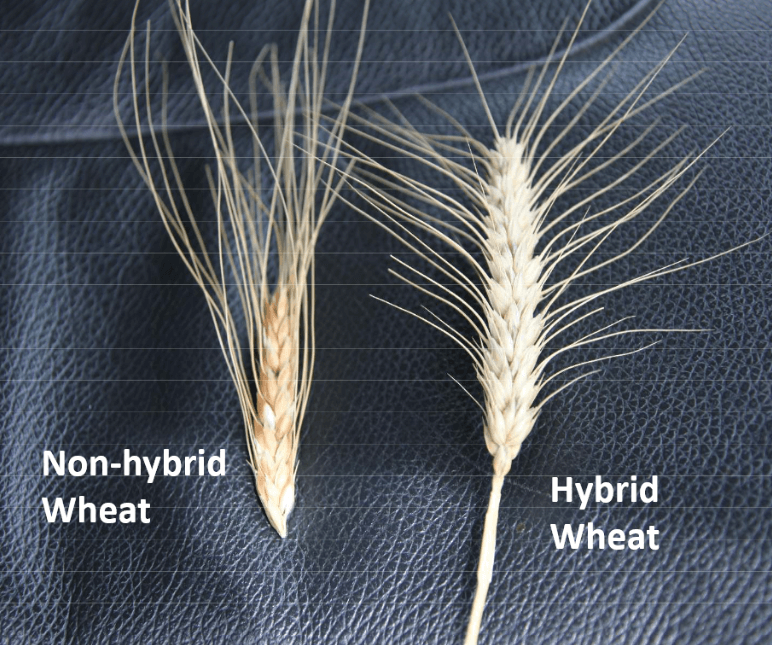Made From Scratch
THEN VS. NOW

"It’s time to return to our ancestral staff of life before geneticists begin manipulating its DNA. Einkorn, the food of ancient civilization, with a natural, unmodified 14 chromosome DNA will impact our future in a positive way."

HANDCRAFTED
- Sourdough Starter
- Sourdough Artisan Loaf
- Focaccia
- Fresh Milled Flour
- Pasta Perfection
- Breakfast Yum!
- Potato Flakes
- Endless Buttermilk
- Homemade Butter
- Apple Cider Vinegar
- Kombucha
HOLISTIC
Incorporating ancient grains into your diet offers a way to enhance overall health by improving digestion, supporting heart and metabolic health, and providing essential nutrients. They are an excellent choice for anyone seeking a more natural, whole-food approach to nutrition.
Uncover the Importance of Ancient Grains: Einkorn, Spelt, & Kamut
Ancient grains offer numerous health benefits due to their nutrient-rich profiles and minimal processing. Here's why they are considered important for your health:
1. High Nutrient Density
- Vitamins and Minerals: Ancient grains are rich in essential vitamins and minerals like iron, magnesium, zinc, potassium, and B-vitamins, which are important for overall health, immune function, and energy production.
- Antioxidants: Many ancient grains, like quinoa, amaranth, and teff, are packed with antioxidants that help combat oxidative stress and inflammation in the body. This can reduce the risk of chronic diseases like heart disease and cancer.
2. Better Digestive Health
- High Fiber Content: Ancient grains tend to have higher levels of fiber than more refined grains, which helps improve digestive health. Fiber supports healthy digestion, prevents constipation, and helps maintain a healthy weight by promoting satiety (feeling full).
- Gut Health: The fiber in these grains also acts as prebiotics, feeding the beneficial bacteria in your gut, which is crucial for a balanced microbiome and optimal digestion.
3. Support for Heart Health
- Cholesterol Management: Ancient grains, particularly those high in soluble fiber like barley and oats, can help lower LDL (bad) cholesterol levels. The fiber in grains like barley contains beta-glucan, which has been shown to help reduce cholesterol.
- Reduced Risk of Heart Disease: The high levels of antioxidants and fiber, along with beneficial fats (like those in quinoa), help protect against cardiovascular disease by improving blood circulation, reducing inflammation, and lowering blood pressure.
4. Blood Sugar Regulation
- Low Glycemic Index: Many ancient grains, such as barley and farro, have a lower glycemic index (GI) compared to refined grains. This means they cause a slower, more steady increase in blood sugar levels, which is beneficial for managing blood sugar, preventing insulin spikes, and reducing the risk of Type 2 diabetes.
- Increased Insulin Sensitivity: Consuming whole ancient grains has been linked to better insulin sensitivity, which helps the body use insulin more effectively, reducing the risk of diabetes.
5. Better Weight Management
- Increased Satiety: The high fiber and protein content of ancient grains helps you feel fuller for longer, reducing overeating and aiding in weight management.
- Healthier Alternative to Refined Grains: Ancient grains are less processed and often more nutritious than refined grains, helping to prevent the empty calorie intake that can contribute to weight gain.
6. Gluten-Free Options
- For Those with Gluten Sensitivities: Many ancient grains like quinoa, teff, and millet are naturally gluten-free, making them suitable alternatives for those with celiac disease or gluten sensitivity. They provide a nutritious option for individuals who need to avoid gluten while still enjoying whole grains.
7. Sustainability and Environmental Benefits
- Less Intensive Farming Practices: Many ancient grains are hardy and resilient crops that require less water, fertilizers, and pesticides compared to modern wheat or corn. This makes them more sustainable and better for the environment, helping to maintain soil health and biodiversity.
8. Rich in Protein
- Plant-Based Protein: Ancient grains like quinoa, amaranth, and farro provide high-quality plant-based protein that is important for muscle repair, immune function, and overall health. Quinoa, for example, contains all nine essential amino acids, making it a complete protein source.
9. Reduced Risk of Chronic Diseases
- Chronic Disease Prevention: Due to their high antioxidant content, anti-inflammatory properties, and nutrient density, consuming ancient grains may help reduce the risk of chronic diseases such as hypertension, cancer, and metabolic syndrome.
10. Cognitive Health
- Brain Function: Ancient grains like oats and barley are rich in nutrients that support brain health, including B-vitamins, magnesium, and fiber. These nutrients play roles in reducing the risk of cognitive decline, improving memory, and supporting mood.
Discover the Pure Goodness of Camel Milk
1. Nutritional Value
Camel milk is packed with essential nutrients that make it a healthy choice. Here’s a look at its key components:
- Low in Fat: Camel milk contains less fat than cow's milk, making it a lighter option for those who want to reduce their fat intake.
- High in Protein: It contains more protein than cow’s milk, which supports muscle building and repair.
- Rich in Vitamins and Minerals: Camel milk is a good source of vitamins such as Vitamin C, A, B vitamins (including B12), and minerals like calcium, iron, zinc, folate, potassium, and magnesium.
- Rich in long-chain and unsaturated fatty acids: supporting brain and heart health
- Less Lactose: Camel milk has lower levels of lactose than cow’s milk, which makes it easier to digest for people who are lactose intolerant.
- Antioxidants: Camel milk has higher levels of antioxidants like Vitamin C and selenium, which help in fighting free radicals and oxidative stres, while promoting overall health.
2. Health Benefits
Camel milk offers several health benefits, which have led to its growing popularity in the wellness community:
- Immune System Support: Camel milk contains immunoglobulins, lysozymes, and lactoferrin, which help in boosting the immune system and fighting infections.
- Diabetes Management: Some studies suggest that camel milk can help reduce blood sugar levels, making it potentially beneficial for individuals with Type 1 and Type 2 diabetes. It contains insulin-like proteins that may assist in controlling glucose.
- Digestive Health: Camel milk is easier to digest due to its lower lactose content and different protein structure. It can be a great alternative for individuals with lactose intolerance or those who struggle to digest cow's milk.
- Anti-inflammatory Properties: Camel milk has anti-inflammatory effects, which may be beneficial for conditions such as arthritis, allergies, and other inflammatory disorders. May help treat inflammatory diseases, including hepatitis, allergies, lactose intolerance, and alcohol-induced liver damage
- Helps with Autism: There is emerging evidence suggesting camel milk may improve the symptoms of autism, although more research is needed. Some parents report improvements in behavior, communication, and sleep in children with autism who consume camel milk.
- Neurodegenerative Benefit: Has been found to have a positive correlation with a reduction in symptoms of Parkinson’s, Alzheimer’s, and other neurodegenerative diseases
3. Why It’s a Great Alternative
- Sustainable: Camels are more resilient in harsh climates and require less water than cows, making camel milk a more sustainable choice for those concerned about environmental impact.
- Allergy-Friendly: Camel milk is less likely to cause allergic reactions compared to cow's milk because its proteins differ in structure. This makes it a potential alternative for individuals allergic to dairy.
- Unique Flavor: Camel milk has a slightly salty, sweet, and nutty flavor, which some people find to be an acquired taste but can be enjoyed in various forms, such as in smoothies, coffee, or even as cheese.
4. Cultural Significance
Camel milk has been consumed for centuries by nomadic communities in the Middle East, Africa, and parts of Asia. It is a staple food in these regions, prized not only for its nutritional benefits but also for its cultural and medicinal significance.
5. Camel Milk vs. Cow Milk
While camel milk is similar to cow's milk in many ways, it’s superior in terms of vitamin C content and has a slightly different balance of proteins and fats.
Here’s how camel milk compares to cow’s milk in terms of nutrition:
| Nutrient | Camel Milk | Cow Milk |
|---|---|---|
| Fat | 3.5% | 3.9% |
| Protein | 3.5% | 3.3% |
| Calcium | 120 mg/100ml | 120 mg/100ml |
| Vitamin C | 5-10 mg/100ml | 0 mg |
| Lactose | 4.8% | 4.7% |
| Iron | 0.9 mg/100ml | 0.0 mg |
6. Availability & INNOVATIONS
Camel milk is not as widely available as cow's milk in most supermarkets, but it can be found in specialty stores or online. It's often sold in powdered form or as fresh milk, though the latter has a shorter shelf life. Some regions, such as the Middle East and parts of Africa, have access to fresh camel milk more easily.
- Camel Milk Products: In addition to fresh milk, camel milk is also used to make a range of products, including cheese, yogurt, ice cream, and even chocolate.
- Research and Development: More research is being done on the benefits of camel milk, especially in terms of its potential for medicinal uses and its role in modern diets.
Camel milk is an increasingly popular alternative to cow’s milk, offering a unique combination of nutrients, health benefits, and cultural significance. It’s especially appealing for those with lactose intolerance, allergies, or those looking for a more sustainable milk option. While it may be harder to find than cow's milk, its growing popularity and versatility are making it a more accessible choice for health-conscious individuals around the world.
Modern Day: "Sourdough is the gateway drug to all things homemade! Once you start with sourdough, there's no turning back."
Pioneer Day: "Through harsh winters and long trails, sourdough kept pioneer families nourished and warm."
Sourdough was a popular staple with the pioneers, who carried their sourdough with them, an easy way to kick start flour recipes when other leavening agents (like yeast cakes) weren’t available in the untouched landscape of the West, where groceries were but a long lost memory. But if you had flour and water then you could make a bread rise (pioneers would also often use potatoes and potato water for their starter). Beyond the usefulness of sourdough starter, it also added flavor, as well as ensured nutrition, which was essential in an era of hardships.

